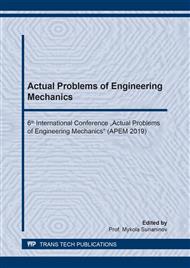[1]
W. Derkowski, Large panels buildings – the possibilities of modern precast industry, Cement, Wapno, Beton, CWB-5/2017: 414-425.
Google Scholar
[2]
W. Derkowski, M. Surma, Complex stress state in prestressed hollow core slabs, Recent Advances in Civil Engineering: Building Structures, CUT Monography 478, 2015: 11-27.
Google Scholar
[3]
W. Derkowski, M. Surma, Influence of concrete topping on the work of prestressed hollow core slabs on flexible supports, Proceedings of 4th International fib Congress 2014, FIB, Mombai, India, 2014: 339-341.
DOI: 10.35784/bud-arch.2180
Google Scholar
[4]
W. Derkowski, M. Surma, Torsion of precast hollow core slabs, Technical Transactions Civil Engineering 3-B/2015: 31-43.
Google Scholar
[5]
M. Surma, W. Derkowski, A. Cholewicki, Analytical model for determining the influence of support flexibility on shear capacity of hollow core slabs, MATEC Web of Conferences, 262, 08005 (2019).
DOI: 10.1051/matecconf/201926208005
Google Scholar
[6]
T.N. Azizov, N.N. Sribnyak, Opredeleniye krutilnoy zhestkosti zhelezobetonnykh elementov pryamougolnogo secheniya s normalnimi treschinami, Resursoekonomni materialy, konstrukcii budivli ta sporudy, 16, p.2 (2008) 8-17. (in Russian).
Google Scholar
[7]
T.N. Azizov, Prostranstvennaya rabota zhelezobetonnykh perekrytii. Teoriya I metody rascheta, Diss. DSc (tech), Poltava, 2006. (in Russian).
Google Scholar
[8]
T.N. Azizov, Uchet nelineynikh svoystv betona pri kruchenii zhelezobetonnykh sterzhnevykh elementov, Sciences of Europe, V. 1, 35 (2019) 19-22. (in Russian).
Google Scholar
[9]
T.N. Azizov, Opredeleniye krutilnoy zhestkosti zhelezobetonnykh elementov s treschinami, Dorogy I mosty. Zbirnyk naukovykh prats, 7 V. 1 (2007) 3-8. (in Russian).
Google Scholar
[10]
A.I. Vereschagina, Napryazhenno-deformirovannoe sostoyanie I prochnost sbornykh zhelezobetonnykh perekrytii, Diss. PhD (tech), Sumy, 2002. (in Russian).
Google Scholar
[11]
DBN V.2.6-98:2009, Konstrukcii budynkiv I sporud. Betonni ta zalizobetonni konstrukcii. Osnovni polozhennya, Minregionbud, Kyiv, 2011. (in Ukrainian).
Google Scholar
[12]
P.F. Drozdov, Konstruirovanie I raschet nesuschikh system mnogoetazhnykh zdaniy I ih elementov, Stroyizdat, Moscow, 1977. (in Russian).
Google Scholar
[13]
N.I. Karpenko, Obschie modeli mehaniki zhelezobetona, Stroyizdat, Moscow, 1996. (in Russian).
Google Scholar
[14]
Rekomendatsii po proektirovaniyu stalnykh zakladnykh detaley dlya zhelezobetonnykh konstruktsii, Stroyizdat, Moscow, 1984. (in Russian).
Google Scholar
[15]
A.S. Semchenkov, Eksperimentalniye issledovaniya sbornykh zhelezobetonnykh perekrytii, opertykh po konturu, TsNIIEP zhilischa, Moscow, 1981. (in Russian).
Google Scholar
[16]
S.P. Timoshenko, Kurs teorii uprugosti, Naukova dumka, Kyiv, 1972. (in Russian).
Google Scholar
[17]
B.E. Ulitskiy, Prostranstvennie raschety balochnykh mostov, Avtotransizdat, Moscow, 1962. (in Russian).
Google Scholar
[18]
O.F. Yaremenko, Yu.O. Shkola, Nesucha zdatnist ta deformatyvnist zalizobetonnykh sterzhnevykh elementiv v skladnomu napruzhennomu stani, Even, Odesa, 2010. (in Ukrainian).
Google Scholar
[19]
A.F. Yaremenko, A.M. Chuchmai, N.A. Yaremenko, Inzhenernaya metodika opredeleniya krutilnoy zhestkosti zhelezobetonnykh balok s normalnymi treschinami, Visnyk Odeskoyi derzhavnoyi akademii budivnytstva ta arhitektury, 33 (2009) 146-151. (in Russian).
Google Scholar
[20]
T. Azizov, O. Melnik, Calculation of reinforced concrete ceilings with normal cracks accounting the Chebyshev approximation, 6 th International Scientific Conference Reliability and Durability of Railway Transport Engineering Structures and Buildings,, (2017) 1-7.
Google Scholar
[21]
T.N. Azizov, Effect of torsional rigidity of concrete elements with normal cracks onto special work of bridges and floorings, International Science Ukrainian Edition, 3 (2010) 55-59.
Google Scholar
[22]
H.J. Cowan, Kruchenie v obychnom i predvaritel'no napriazhennom zhelezobetone, Stroyizdat, Moscow, 1972. (in Russian).
Google Scholar
[23]
D. Kochkarev, T. Azizov, T. Galinska, Bending deflection reinforced concrete elements determination, MATEC Web of Conferences, (2018).
DOI: 10.1051/matecconf/201823002012
Google Scholar
[24]
ENV 1992-1. Euroсode 2. Design of concrete structure. Part 1, General rules and rules for buildings, GEN, (1993).
Google Scholar


